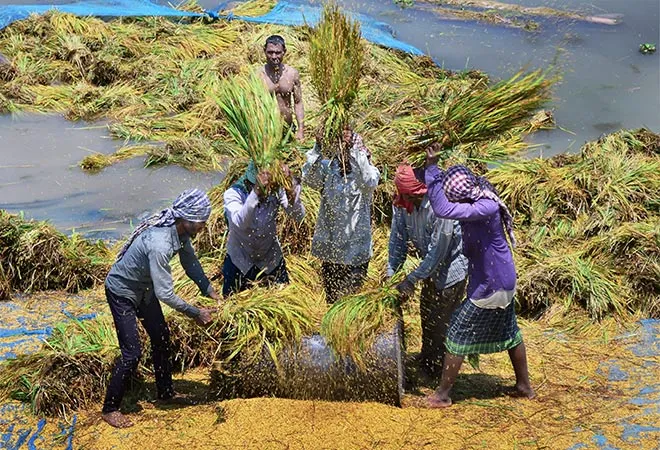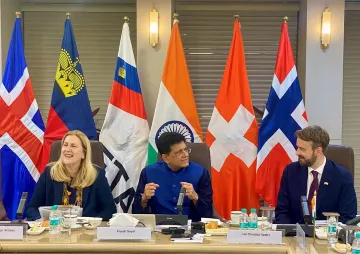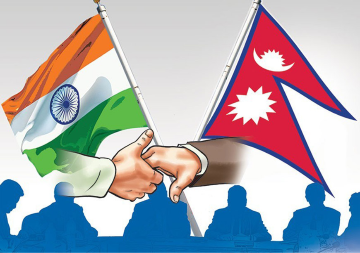
From loan melas of the 1980s to debt relief in 2008 to farm loan waivers of today, the language of bad economics may have changed but the end product --- creating and enlarging the pool of defaulters --- has remained the same. Once the staple pre-election diet to capture or purchase power through the votes of ‘poor’ farmers, the five-year exercise of waiving loans has now mushroomed into delivering electoral promises, consolidating a bad practice that will turn India’s democracy into one that legitimises default, powers a dangerous financial incentive structure, nudges its citizens into becoming defaulters, and our country a defaulter nation.
On 7 May, Punjab Chief Minister Captain Amarinder Singh said that as part of his commitment to implementing the promised loan waiver in his electoral promise, the State’s Farmers’ Commission will work out modalities and give viable recommendations in two months. He said his government would do better than what the Rs 1 lakh waiver the Uttar Pradesh (UP) government had promised. On the same day, about 1,500 km south, Shiv Sena chief Uddhav Thackeray said he would launch a campaign titled ‘I shall be debt free’ that would focus on the plight of farmers in Maharashtra. But the campaign is a misnomer: what Thackeray wants is a loan waiver, not good practices that put farmers on their feet.
In fact, Punjab and Maharashtra are riding a momentum built last month, when with a huge political mandate behind him and political expectations woven into that verdict, UP Chief Minister Yogi Adityanath’s cabinet in its first meeting decided to waive off famers’ loans of up to Rs 1 lakh. A quick snapshot of what the UP numbers look like:
* The cost of this waiver: Rs 36,000 crore. To put this number in perspective, UP’s 2015-16 budget estimates its gross fiscal deficit at Rs 31,560.
* The number of beneficiaries: 8.6 million, which means an average benefit to each person works out to Rs 41,860.
* If taken on the books, the waiver would effectively have doubled the fiscal burden, though the number will be updated following the new government’s first budget.
* But to finance this waiver, the UP government has decided to float Kisan Rahat Bonds, the details of which are awaited. If we assume that the entire burden of the waiver is financed by these bonds, the government will be borrowing to waive the loans. At what cost? For these bonds to be viable, the interest rate, if backed by a state guarantee that would reduce the cost, will be more than that what farmers are paying --- the risk-free return today stands at around 8%.
* The broad contours of crop loans are as follows. On loans of upto Rs 3 lakh, the interest rate is 7%. An interest subvention of 3% effectively brings the cost of the loan down to 4%.
The UP government has to choose between a rock and a hard place. If it borrows to pay, the cost would be double of existing loans. If it takes the waiver on its books, it doubles the fiscal deficit. We wait for details.
What seems to be economically bad may not be so when looked at through the prism of politics. For numbers-obsessed tribe of economists, loan waiver signals that good politics thrives on a diet of bad economics. And when easy economics is there to finance complex politics, the trickle-down is instant. Thackeray is only echoing Maharashtra Chief Minister Devendra Fadnavis, who said he was studying the UP farm loan waiver model and had asked the State’s finance secretary to “draft a table explaining all the mathematics” behind UP government’s decision. Likewise, Amarinder Singh’s latest statement is only a follow-up of what he said earlier --- that he would ensure farmers are “freed of their mounting debts”, through farm waivers, and for which “the State machinery has already been set into motion.”
Compounding bad economics is bad law. While the political rhetoric in most such waivers is the ‘poor’ farmer under which the rich farmers enjoy the benefits, some State governments, to their credit, are attempting to fix this problem. The UP government is waiving off upto Rs 1 lakh worth of loans, so there is an upper limit, while the Tamil Nadu government restricted the benefits of loan waiver to small and marginal farmers. But on the appeal of large farmers, the judiciary has set a new precedent.
In its 4 April 2017 order, the Madras High Court stated that waiving farm loans cannot be restricted to small and marginal farmers only --- the loans of those with farms larger than 5 acres must be waived off too. Selective waivers, even to the needy, violates Article 14, which is a guarantee against arbitrariness of state action, the order states. To put the matter in numerical perspective, the court has effectively ruled that the average benefit of loan waiver to small and marginal farmers that works out to Rs 34,118 per farmer needs to be given to large farmers, each of whom will now get Rs 65,590 on average. Worse, the order is “hopeful” that Central government will come to the aid of the State government, whose finances are “grim”.
The endgame in all such waivers is a defaulter nation, where moral hazard is another name for economic governance, whose policy prescriptions are incentives to not pay loans, the legitimisation of defaults, and celebration of its defaulters. “Waivers engender moral hazard,” Reserve Bank of India governor Urjit Patel said. “It undermines honest credit culture, it impacts credit discipline, and it plugs incentives for future borrowers to repay.” Such acts need to be eschewed and need political consensus, “Otherwise, some sovereign fiscal challenges could eventually affect the national balance sheet.”
Patel is neither the first nor would be the last RBI governor to say so. So long as the politics of loan waivers goes on, one State at a time, voices of sanity will stand up and speak. As far back as 1987, when Haryana Chief Minister Devi Lal signed a loan waiver order, then RBI governor R.N. Malhotra told him he couldn’t. His argument was that only commercial banks can write-off loans, and they have to follow RBI guidelines. Technicalities aside, the big picture message three decades ago was the same: such actions would damage the recovery climate. In other words, create a moral hazard.
Moral hazard
What is a moral hazard? According to Paul Krugman, “any situation in which one person makes the decision about how much risk to take, while someone else bears the cost if things go badly” is a moral hazard. For greater clarity on the subject, read this lecture by Robert Shiller. Politics may sway power, legitimise inefficient policy, even undertake socially ‘moral’ financial expeditions. But bad ideas need to be highlighted. “If the absence of dissent means that we have become more tolerant of moral hazard, the consequences could be catastrophic,” warned Peter L. Bernstein in a 2009 paper. “Look into the future and imagine the next bubble --- for there will be one someday.”
From theory to practice, the hazards accompanying loan waivers in India are many. First, it allows a highly intelligent agricultural electorate to play one party against another by turning loan waivers into a product of mass default --- get a political party to promise a waiver, then ensure it makes good the promise. Second, it creates a culture, where non-payment of debt becomes a legitimate practice. Third, it tells those who do repay their loans that they are a bunch of fools, their sound economics is out of sync with the mass waiver politics. Fourth, it creates financial repression --- to make good the loss due to waivers, banks will have to reduce interest rates for their depositors and increase fees. Fifth, if the waiver is being pushed on the fiscal balance sheets, it will increase inflation and hit the poor hardest. Sixth, if the solution is to increase taxes, it will squeeze the same small pool of honest taxpaying citizens.
Moral hazard comes in various shapes and sizes. Karur Vysya Bank chairman and CEO P.T. Kuppuswamy had reported farmers’ shifting of accounts to nationalised banks well before elections, expecting loan waivers. “We were wondering why they are shifting the accounts and then farmers came and told it’s an election year. Definitely there will be a write off. If it’s a private sector bank then you might not get a waiver,” he said.
The other hazard that politicians and policymakers confront when talking about loan waivers is the focus on large numbers --- so many thousands of crores of rupees to benefit so many lakh farmers. These numbers mislead and are risky to use. The reality is deeper and granular. When we examine the NSSO (National Sample Survey Office) data across two series, 2003 and 2013, we see interesting numbers around UP. While the average loan size of marginal farmers (land size of 1 hectare or less) increased by 4.6 times between the two surveys, that of large farmers (5 hectares or more) jumped by 11.4 times, an inequality that has gone unreported.
What has also gone unreported is the diversity of farm economics across States. The large farmer in UP, for instance, borrows 17 times more than the marginal farmer --- the number in Punjab 3.7 times, 6.3 times in Maharashtra, and 5.2 times across India. On the other side, the large farmer in Tamil Nadu has seen his borrowings fall --- repeat fall --- by 90%, from Rs 52,427 in 2003 to Rs 4,759 in 2013. During the same period, the average loan of a marginal farmer rose by 6.2 times to Rs 59,548; the marginal farmer’s average loan was 12.5 times more than the large farmer’s. There is no one-size-fits-all policy across States.
Looked at from another window, the fact that wealthy farmers capture most of agricultural credit has been established beyond doubt. “A comparison of figures for 2000 with those of 2006 shows that the shares in total advances of advances with credit limit ‘less than Rs 25,000’ and ‘between Rs 25,000 and Rs 2 lakh’ have shrunk significantly,” R. Ramakumar and Pallavi Chavana argued in a 2008 paper. The share of loans of upto Rs 25,000 fell from 35.2% in 2000 to 13.3% per cent in 2006; those between Rs 25,000 and Rs 2 lakh fell from 32.4% to 31.4%. But share of advances of above Rs 25 crore increased sharply from 5.7% to 16.8%. This is a set of statistics that every policymaker must read before designing a loan waiver policy --- the rich elite captures most of the loans, and by default, most of the waivers as well.
But let us not begin bashing the wealthy farmers. They are economic agents, not evil. They are merely using existing policies to do what every other agent does: maximise returns. They are a symptom of moral hazard --- not its cause. Coming to the rescue of this policy hijack is technology. With more than 1 billion Aadhaars generated so far, and 282 million bank accounts opened under the Jan Dhan Yojana, mapping the poor is no longer the challenge it once was. Using these two tools alone, governments can direct targeted benefits, be it in education, healthcare, insurance --- and loan waivers.
Presuming governments are able to undertake targeted waivers, there is another set of evidence that they must keep in mind before embarking on such journeys: loan waivers do not help farmers. “Credit as the vehicle for routing relief to farmers is a flawed choice,” argues N. Srinivasan, consultant at Rural Finance and Development. “There is no evidence to suggest that increasing credit flow has resulted in increased production in agriculture or profitability.” It may be a tool of liquidity and smoothening the consumption and production needs of the farmer, he writes. But “credit as a vehicle of relief is not a ‘fit’ instrument.”
But the biggest reason why debt waivers must end is simply this: they do not work. In a November 2014 working paper, Xavier Gine and Martin Kanz, both from the World Bank, concluded that the Rs 60,000 crore 2008 debt waiver “had no effect on productivity, wages, or consumption, but led to significant changes in credit allocation and an increase in defaults”. One fallout of the bailout was a “significant reallocation of bank lending away from districts with greater exposure to the bailout”. They found that the scheme led to significant moral hazard in loan repayment.
That’s why all those who create and support loan waivers rest their arguments on non-economic parameters. They use emotions to counter facts. They create a smokescreen of political and societal sorrow behind which to hide bad economics. “We keep talking about the animal spirits of businessmen,” then Prime Minister Manmohan Singh said of the 2008 debt waiver. “But I think the farmers are the biggest businessmen of our country. They produce essential commodities required by us. If their animal spirits are depressed, it is not good for the country.”
One argument that supports loan waivers to farmers is this: if debt of wealthy companies and their promoters can be restructured or even thrown into the non-performing asset (NPA) bin, why this hue and cry over millions of ‘poor’ farmers? There are two answers to this question. First, while it is true that the debt of several companies and their promoters has been waived, partially because of collusion between politics, banking and promoters and partially to ensure the company keeps running to pay the loan in the future, one bad practice does not justify another. Even there, we are seeing such practices coming to an end. Vijay Mallya’s case points to the beginning of the end of this rampancy. And second, on the legal side, the newly-enacted Insolvency and Bankruptcy Code will ease the process of debtor-creditor relationship and ensure a smoother recovery of loans from the corporate sector.
In a fast-changing India, loan waivers and the accompanying moral hazards are yesterday’s solutions. They encourage bad financial behaviour. They are a race to the fiscal bottom. They build a competitive politics of a nanny state. They prevent citizens from taking rational decisions, both economic and political. They must end. Else, we will end up breeding a defaulter nation.
The views expressed above belong to the author(s). ORF research and analyses now available on Telegram! Click here to access our curated content — blogs, longforms and interviews.




 PREV
PREV



